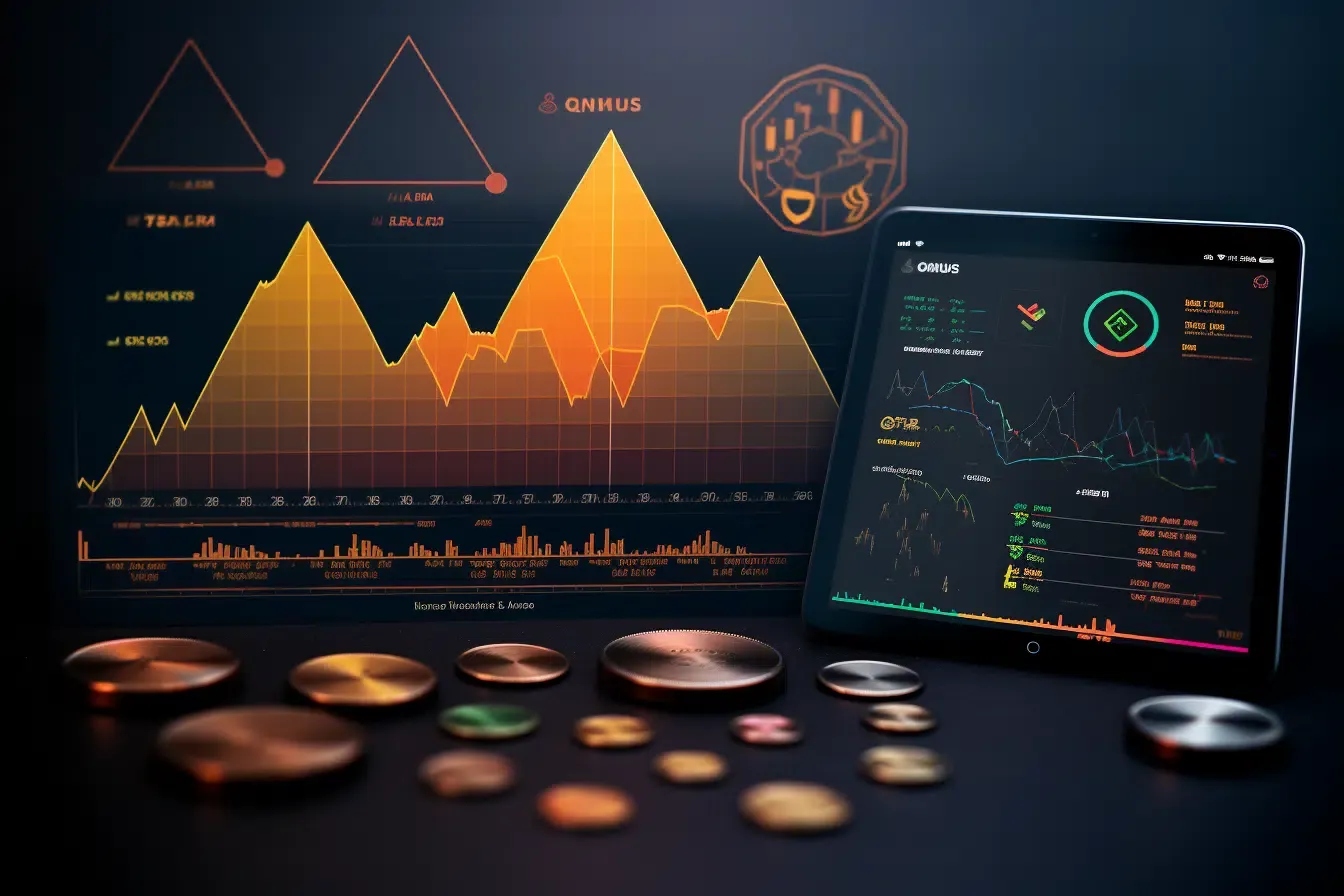15 Best Indicators for Crypto Price Prediction Analysis in 2025
Master crypto forecasting with our blog! Dive into the realm of price prediction and technical analysis with our curated list of the top 15 indicators essential for navigating the 2025 market.

In the dynamic realm of cryptocurrency trading in 2025, leveraging precise and powerful analytical tools is paramount for navigating the market’s volatility and predicting price trends. Technical indicators play a crucial role in forecasting future price movements by analyzing past market data. However, many traders seek technical indicators for crypto prediction.
This guide highlights the 15 most effective indicators for crypto price prediction analysis to help you navigate the crypto domain.
Top 15 crypto price prediction indicators
Take a look at the best 15 indicators that help traders with price prediction in 2025:

Looking at the best technical indicators for crypto price prediction
1. Moving Averages (MA)
MAs are crucial technical indicators for crypto that are used extensively in cryptocurrency trading to smooth out price trends over a specified period, helping traders identify the direction of the market momentum.
There are several types of moving averages, with the Simple Moving Average (SMA) and the Exponential Moving Average (EMA) being the most popular. SMAs calculate the average price of a cryptocurrency over a specific period, equally weighting each data point. In contrast, EMAs give more weight to recent prices, making them more sensitive to new price movements.
A crossover of two MAs, such as a short-term MA crossing above a long-term MA (golden cross) or vice versa (death cross), can signal entry or exit points for traders.
For a focused investment approach, considering how many Cardano you might need to hold to become a millionaire by 2034 can offer a specific goal for enthusiasts of this particular cryptocurrency.
2. Moving Average Convergence Divergence (MACD)
The MACD is a technically involved and complex indicator that measures the momentum of price changes by illustrating the relationship between two moving averages of a cryptocurrency’s price.
It consists of two lines: the MACD line, which is the difference between a fast and a slow EMA (usually the 12-period EMA minus the 26-period EMA), and the signal line, which is an EMA of the MACD line (typically the 9-period EMA). When the MACD line shoots past the signal line, it indicates bullish momentum, suggesting it may be a good time to buy.
Conversely, a cross below the signal line signals bearish momentum, potentially a good time to sell. The MACD histogram, which plots the precise distance between the MACD line and the signal line, provides a visual representation of the momentum strength.
3. Relative Strength Index (RSI)
The RSI is a recognized momentum oscillator that helps to measure the speed and alteration of price movements, indicating overbought or oversold conditions of a cryptocurrency.
The RSI mostly oscillates between 0 and 100, typically using a level of 70 to indicate overbought conditions and 30 for oversold conditions. An RSI above 70 suggests that a cryptocurrency may be overvalued and could be primed for a price reversal or correction, while an RSI below 30 indicates undervaluation, potentially leading to a price increase.
The RSI can also help identify divergence. Furthermore, if the price of a cryptocurrency makes a new high but the RSI does not, it could indicate weakening momentum and a possible trend reversal.
Before diving into the complex world of indicators, beginners may benefit from these 5 best free crypto technical analysis courses to solidify their foundational knowledge.

How technical indicators help in predicting trends
4. Stochastic Oscillator
The Stochastic Oscillator is a recognized momentum indicator that contrasts a cryptocurrency’s closing price with its range of prices over a given time frame. This indicator shows overbought conditions above 80 and oversold conditions below 20, fluctuating between 0 and 100.
The two lines that make up the stochastic oscillator are the %D line, which is a moving average of the %K line, and the %K line, which indicates the current price level in relation to the high-low range. The intersection of these two lines may indicate a shift in the price momentum. In particular, a crossover above the oversold level may indicate a level to buy, while a crossover below the overbought level may indicate a level to sell.
The Stochastic Oscillator is particularly useful for identifying reversals, overbought or oversold conditions, and potential price pullbacks or bounces within a broader trend. This makes it a crucial crypto indicator.
5. Williams %R
The Williams %R, also known as the Williams Percent Range, is a technical analysis indicator similar to the Stochastic Oscillator, designed to identify overbought and oversold levels. It comprehends the level of the close relative to the high-low range measured over a specified period, usually 14 days.
The indicator ranges from -100 to 0, with readings above -20 indicating overbought conditions and readings below -80 suggesting oversold conditions. This can help traders anticipate trend reversals and make informed trading decisions by identifying the potential for a price bounce or pullback from these extreme levels.
The Williams %R is particularly useful in choppy market conditions, where it can signal short-term price reversals and provide traders with quick, actionable insights.
6. Bollinger Bands
John Bollinger invented the Bollinger Bands volatility indicator, which is comprised of two outer bands plotted with two standard deviations deflecting away from the middle band and a middle SMA, typically a 20-day SMA.
When market volatility is high, Bollinger Bands expand to indicate stronger movement, and when volatility is low, they contract to indicate consolidation. The tool is incredibly versatile, providing signals for trend following, momentum trading, and range-bound strategies. Traders can look for price breakouts above or below the bands as potential signals for entering or exiting trades or use the bands along with other indicators to ensure trend strength and potential reversal points.
Bollinger Bands also help identify the “squeeze,“ a condition where the bands come close together, indicating a possible upcoming increase in volatility and, hence, a strong move in the price.

Effects of using technical indicators on charts
7. On-Balance Volume (OBV)
The OBV is a well-known cumulative indicator that utilizes volume flow to forecast changes in stock price. The premise of OBV is based on the distinction between smart money – supposedly knowledgeable and professional investors who can predict future market movements – and less informed retail investors.
The OBV increases or decreases during each trading day in correlation with the price’s closing level. A rising OBV reflects positive volume pressure, which can indicate higher prices, while a falling OBV indicates negative volume pressure, which can result in lower prices. By comparing the direction of the OBV to price trends, traders can identify potential price reversals.
For example, if the price is rising but the OBV is flat or falling, the price may be near its top. Conversely, if the price is plummeting and the OBV is flat or rising, the price could be nearing its bottom.
8. Accumulation / Distribution Line (ADL)
The ADL is a widely used volume-based indicator that measures the cumulative flow of money into and out of a security or crypto. It accomplishes this by comparing the close to the range (high and low) of a trading period and weighting the result by the period’s volume.
When the ADL rises, it suggests the accumulation of security, as most of the trading volume is associated with upward price movements. Conversely, when the ADL is falling, it indicates distribution, with most of the trading volume occurring on price declines.
Discrepancies between the ADL and the asset’s price trend can signal weak movements that are likely to reverse. For instance, if the price is rising but the ADL is declining, it may suggest underlying selling pressure that could lead to a price drop.
9. Directional Movement Index (DMI)
The DMI is an indicator developed by J. Welles Wilder to determine the strength of a price trend. The DMI consists of two main lines, the Positive Directional Indicator (+DI) and the Negative Directional Indicator (-DI), which help identify the direction of the trend.
When the +DI line is above the -DI line, it suggests a bullish trend, indicating that buying pressure is stronger. Conversely, when the -DI line is above the +DI line, it suggests a bearish trend, indicating stronger selling pressure. Traders use the Average Directional Index (ADX) feature within the DMI to assess the trend’s strength.
A higher ADX value typically indicates a stronger trend, whether it’s up or down, providing traders with insights into whether a trend is worth following.
For those aiming to leverage their knowledge of indicators for long-term success, discovering strategies on how to become a crypto millionaire by 2030 could offer valuable guidance.

Unraveling the accuracy of using technical indicators
10. Chaikin Money Flow (CMF)
The CMF combines price and volume to measure the buying and selling pressure for a specific period. The CMF oscillates around a zero line, with positive values indicating buying pressure and negative values indicating selling pressure.
A positive and increasing CMF suggests that the market is strong, as the majority of trading volume is associated with upward price movements. Conversely, a negative and decreasing CMF indicates market weakness, with most of the trading volume occurring on down days. Traders can use the CMF to confirm trend direction or anticipate reversals when divergences occur between the indicator and the price action.
11. Relative Volume (RVOL)
RVOL indicator compares the current trading volume of crypto to its historical trading volume over a specific period, providing insight into how actively a cryptocurrency gets traded relative to its past.
A higher RVOL indicates that the asset gets traded more actively than usual, which reflects significant price movements, either up or down. Conversely, a lower RVOL suggests less trading activity, which might indicate consolidation or a lack of interest in the asset at its current price level.
RVOL can be a powerful tool for traders looking to gauge the strength of a price move or identify potential breakout or breakdown points based on unusual volume activity.
12. Rate of Change (ROC)
The ROC helps to understand the percentage change in price, typically between the current price and the price calculated a certain number of periods ago. Moreover, this highlights the speed at which a cryptocurrency’s price keeps fluctuating.
It provides in-depth insights into the momentum of the price movement within the market. A positive ROC indicates that prices are increasing and suggests bullish momentum, whereas a negative ROC suggests bearish momentum with prices decreasing.
Regulatory actions significantly influence market movements. Also, the ongoing saga of Binance vs. SEC provides crucial context for understanding how regulations can impact crypto prices.

The challenges with using technical indicators
13. Standard Deviation
Standard Deviation is a statistical measure used in financial markets to quantify the amount of variation or dispersion of a set of values. In the context of cryptocurrency trading, it measures the volatility of a cryptocurrency’s price. Moreover, this indicates how widely prices may scatter from the average or mean price.
A high Standard Deviation indicates that the price of the cryptocurrency is highly volatile, with large price movements in either direction. Conversely, a low Standard Deviation suggests that the price is more stable, with less dispersion from the average. Traders use the Standard Deviation to assess the risk associated with a cryptocurrency’s price movements.
14. Ichimoku Cloud
The Ichimoku Cloud, or Ichimoku Kinko Hyo, is a comprehensive indicator for crypto that defines support and resistance, identifies trend direction, gauges momentum, and provides trading signals.
It consists of five main components: Tenkan-sen (conversion line), Kijun-sen (baseline), Senkou Span A (leading span A), Senkou Span B (leading span B), and the Chikou Span (lagging span). These components combine to form the “cloud,” which projects potential support and resistance levels into the future, offering traders a unique perspective on market trends.
A key feature of the Ichimoku Cloud is its ability to provide a clear visual representation of the market’s current state and its future direction. Moreover, this makes it a favored tool among traders for its depth of information and ease of interpretation.
15. Fibonacci Retracements
The concept behind Fibonacci Retracements is that markets will retrace a predictable part of a move before continuing in the original direction. This allows traders to identify possible support and resistance levels. These retracements are based on Fibonacci numbers (0.236, 0.382, 0.5, 0.618, 0.786), which are derived from the Fibonacci sequence.
Traders use these levels as indicators for placing entry orders and setting stop-loss levels or target prices. Fibonacci Retracements work with both uptrends and downtrends. Traders prefer them because they predict levels of interest in the financial markets with surprising accuracy.
They work best when the market is trending, and they provide a deeper insight into the potential reversal points in price action, allowing traders to make more informed decisions about their trades.
Mining profitability can sway market supply dynamics. Explore the best coins to mine in 2024 and get a perspective on which cryptocurrencies might be most affected.

The futuristic improvements in technical indicators
Wrapping up
The array of indicators discussed represents essential tools for anyone looking to understand and anticipate the fluctuations of the crypto market in 2024. While each indicator has its unique strengths, successful trading strategies often emerge from a combination of these tools, bolstered by continuous learning and effective risk management.
As the crypto landscape evolves, adaptability and a well-rounded analytical approach will be key to seizing opportunities and navigating the market’s complexities with confidence.




